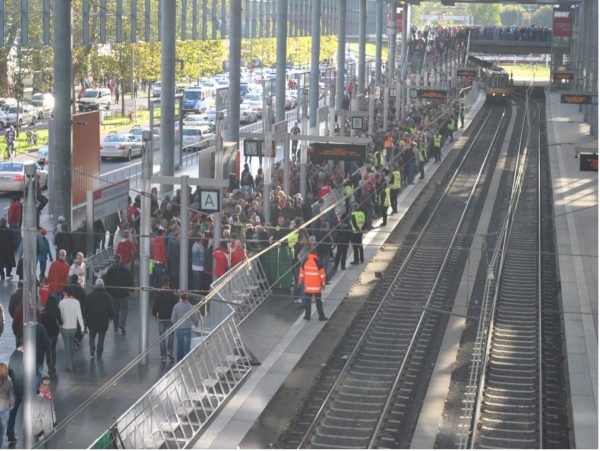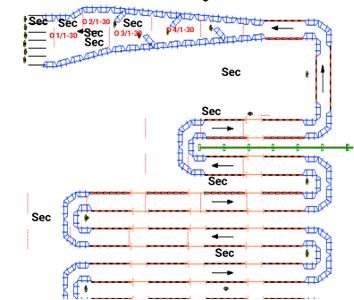Crowd Management: 5 The Ingress & Egress Areas
Ingress areas to events – whether infrastructure-controlled access to a venue with restricted access or an open access area on a public event site – are of particular importance in the context of event security planning. They are important for the visitor’s first impression of the event, offer space for action and control of visitors (e.g. as part of admission controls) and often have to withstand a changing load that cannot always be predicted in advance (“early arrivals”).
The ingress and egress areas also represent a difficult legal space, as they form the transition between the organiser’s area of responsibility and public safety at a point, which is not always clearly defined.
However, based on an understanding of entrance and admission areas as multifunctional transfer, waiting, action and prevention areas that goes beyond this limited consideration, more far-reaching requirements must be placed on these areas. When planning entrance and admission areas, it must be taken into account that these areas
- often define the visitor’s first contact with the event space
- form an interface between the inner and outer areas- i.e. must be balanced in terms of inflow and outflow
- form a (first) interaction area with the waiting visitor
- represent the working area for the security and event organisation service – with far-reaching effects on security within the event site
- form an access or even attack point that is easy for an attacker to reach
Analogous to the requirements for entrance areas, the exit areas are also an interface between internal and external development – i.e. waiting areas and transfer points (to public transport, cars) must be defined, information must be provided (“how long do the trains run?”, “where does P3 go?”) and personnel and – if necessary – infrastructural support must be provided to guide visitors.

Figure 2: Organisation of a train station directly located in an egress area of an arena.
The transfer of responsibility between the security provided by the organiser and public safety must also be clarified here.
Entrances for access-controlled events
In the context of access-controlled events, entry gates are regularly used to separate visitors and thus to enable a structured control of visitors (admission ticket and control of prohibited items).
The following factors must be taken into account when calculating a sufficient number of locks:
- Number of visitors
- Number of staff
- Search intensity
- Visitor profile
- Planned admission time
- Control regulations (bag bans, photography bans, etc.)
It is important to ensure that visitors are directed to the actual entrances and that there is no uncontrolled queuing in front of the entrances. As part of an orderly flow of visitors to the entrances, accompanying organisational measures are always necessary to both accompany the waiting time and to ensure a continuous flow of people and prevent sudden movements or the build-up of pressure
It may be necessary to
- obstruct the view of the actual entrances: this prevents sudden movement and forward pressure when opening the entrances
- define delimited areas (“containers”) in the queues that can be processed “piece by piece”
- make organisational arrangements so that visitors can leave waiting areas (e.g. go to the restroom) and then return to their position (naming of areas and numbering of visitors, e.g. C 36 = visitor no. 36 in queue section C)
- to ensure that queues can be addressed and monitored continuously – especially for longer waiting times at high temperatures or in areas without shaded areas

Figure 1: An organized queue.
In many cases, visitors spend more time in the entrance areas than just the transfer time – this can be a few minutes or even several hours. On the one hand, this time can be used to provide necessary information (e.g. further routing behind the entrance area). On the other hand, it must be ensured that communication with all those waiting is possible over the entire period – this is particularly relevant in the case of very long waiting times, very complex access situations and, of course, in the event of incidents and damage situations. In particular, it must be ensured that visitors who may be pushing for admission from behind can be addressed in order to relieve the front areas.
Organisation:
Almost all admission areas must be organised. This includes keeping the areas free of unwanted or disruptive structures and / or activities (e.g. distribution of brochures, rubbish etc.) as well as the management of those waiting. This includes addressing and being approachable as well as controlling processes. At the entrances themselves, it must be ensured that a suitable number of staff are available to process the inflow while maintaining the intensity of control.
Legal considerations:
When planning admission areas, it must be regularly checked in whose area of responsibility the areas lie. It regularly happens that the areas directly in front of the entrances are already in public space and are no longer event areas. Under certain circumstances, this means that the organiser cannot implement any control measures with the help of infrastructure or that these must be coordinated in advance with the relevant approval authorities.
Literature
DIN EN 13200-7:2014-06, Spectator facilities – Part 7: Entrance and exit facilities and walkways
FGSV e.V. (2022): Recommendations on Traffic and Crowd Management for Events. Requirements, Standards and Options for Action for Consideration in the Planning, Approval Processes and Putting on of Events.
______________________________________________________
Read all articles from this series on event safety:
Safety Planning for Events: An Introduction
The Risk Management Circle in the Context of Events: 1 Introduction
The Risk Management Circle in the Context of Events: 2 Risk Identification
The Risk Management Circle in the Context of Events: 3 Risk Assessment
The Risk Management Circle in the Context of Events: 4 Risk Response
The Risk Management Circle in the Context of Events: 5 Risk Monitoring and Review
The Risk Management Circle in the Context of Events: 6 Risk Mitigation
Crowd management: 1 An Introduction
Crowd Management: 2 The need of a systematic approach
Crowd Management: 3 The people
Crowd Management: 4 Safety by Design
Crowd Management: 5 The Ingress and Egress Areas
Emergency planning: Introduction
Emergency Management: 1 Emergency Plans
Emergency Management: 2 Scenarios
Emergency Management: 3 Learning from Disasters

